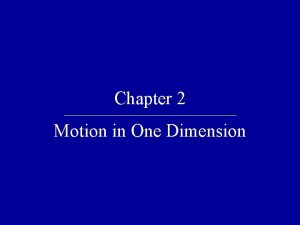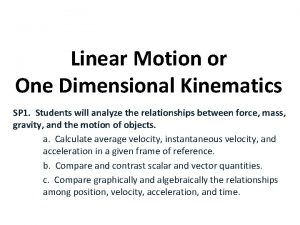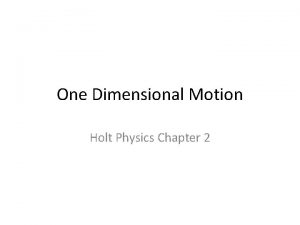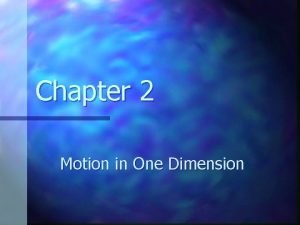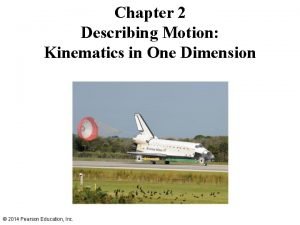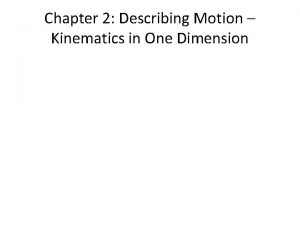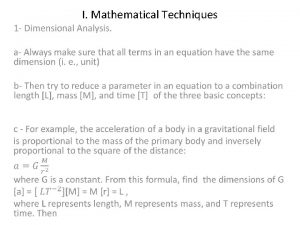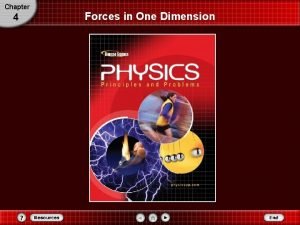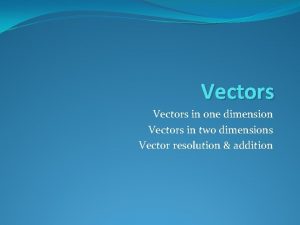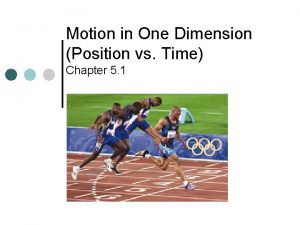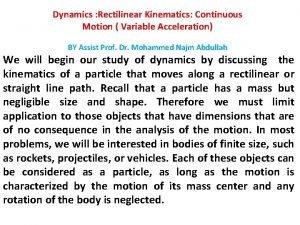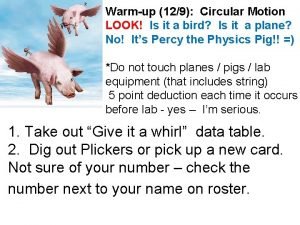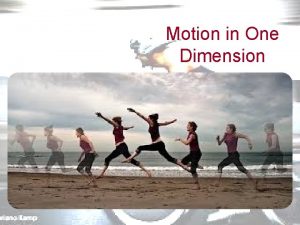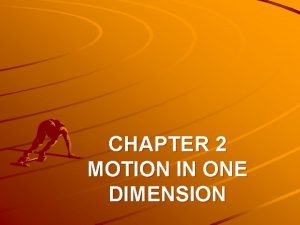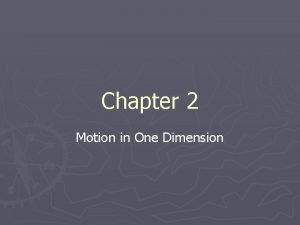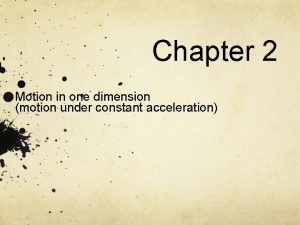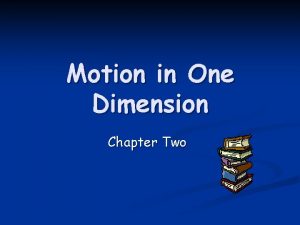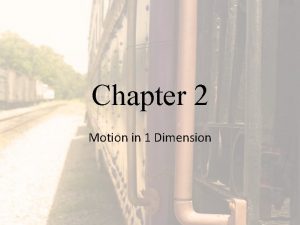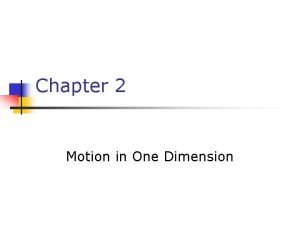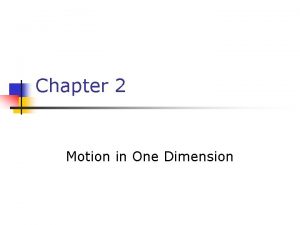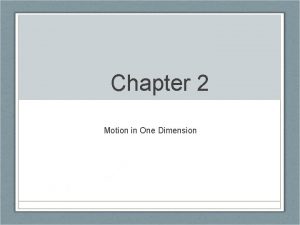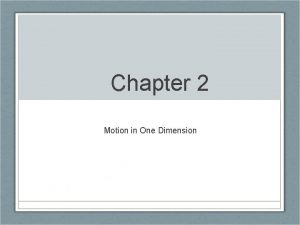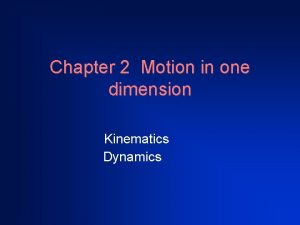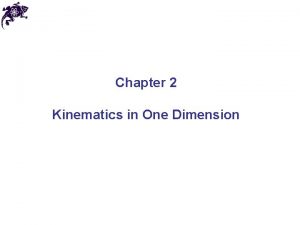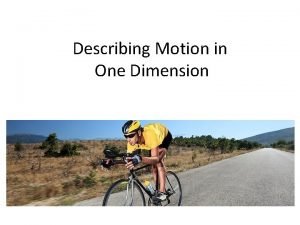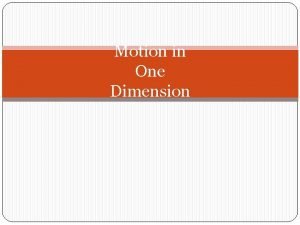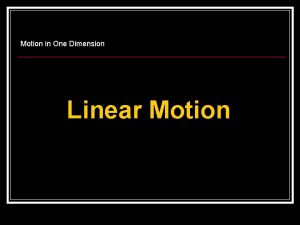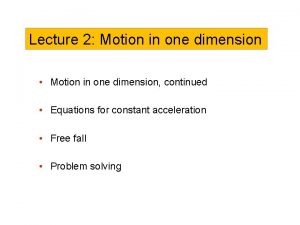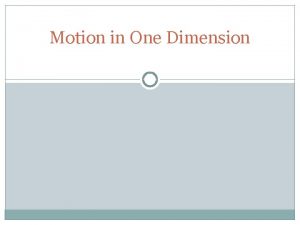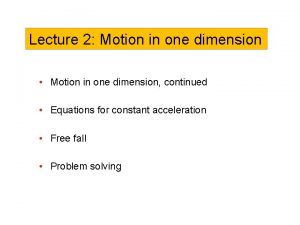Chapter 2 Motion in One Dimension Dynamics Dynamics



































- Slides: 35

Chapter 2 Motion in One Dimension

Dynamics • Dynamics: branch of physics describing the motion of an object and the relationship between that motion and other physics concepts • Kinematics is a part of dynamics. In kinematics we are interested in the description of motion, without the description of the cause of the motion • Any motion involves three concepts used to study objects in motion: 1) Displacement 2) Velocity 3) Acceleration

Linear motion In this chapter we will consider moving objects: • Along a straight line • With every portion of an object moving in the same direction and at the same rate (particle-like motion)

Types of physical quantities • In physics, quantities can be divided into such general categories as scalars, vectors, matrices, etc. • Scalars – physical quantities that can be described by their value (magnitude) only • Vectors – physical quantities that can be described by their value and direction

Distance, position, and displacement • Distance (scalar) a total length of the path traveled regardless of direction (SI unit: m) • In each instance we choose an origin – a reference point, convenient for further calculations • Position of an object (vector) is described by the shortest distance from the origin and direction relative to the origin • Displacement (vector) – a change from position xi to position xf

Velocity and speed • Average speed (scalar) - a ratio of distance traveled (over a time interval) to that time interval (SI unit: m/s) • Average velocity (vector) - a ratio of displacement (over a time interval) to that time interval • Instantaneous velocity (vector) – velocity at a given instant • Instantaneous speed (scalar) – a magnitude of an instantaneous velocity

Velocity and speed

Velocity and speed

Instantaneous velocity • The instantaneous velocity is the slope of the line tangent to the x vs. t curve • This would be the green line • The light blue lines show that as Δt gets smaller, they approach the green line

Acceleration • Average acceleration (vector) - a ratio of change of velocity (over a time interval) to that time interval (SI unit = (m/s)/s = m/s 2) • Instantaneous acceleration (vector) – a rate of change of velocity at a given instant

Acceleration • The blue line is the average acceleration • The slope (green line) of the velocity-time graph is the acceleration

Case of constant acceleration • Average and instantaneous accelerations are the same • Conventionally • Then

Case of constant acceleration • Average and instantaneous accelerations are the same • Conventionally • Then

Case of constant acceleration To help you solve problems Equations Missing variables

Case of constant acceleration

Case of constant acceleration

Graphical representation

Graphical representation

Graphical representation

Graphical representation

Graphical representation

Graphical representation

Graphical representation

Graphical representation

Graphical representation

Chapter 2 Problem 36 A car accelerates uniformly from rest to a speed of 40. 0 mi/h in 12. 0 s. Find (a) the distance the car travels during this time and (b) the constant acceleration of the car.

Case of free-fall acceleration • At sea level of Earth’s mid-latitudes all objects fall (in vacuum) with constant (downward) acceleration of a = - g ≈ - 9. 8 m/s 2 ≈ - 32 ft/s 2 • Conventionally, free fall is along a vertical (upward) y-axis

Chapter 2 Problem 45 A certain freely falling object requires 1. 50 s to travel the last 30. 0 m before it hits the ground. From what height above the ground did it fall?

Questions?

Answers to the even-numbered problems Chapter 2 Problem 4: 12. 2 mi/h

Answers to the even-numbered problems Chapter 2 Problem 8: (a) 2. 3 min (b) 64 mi

Answers to the even-numbered problems Chapter 2 Problem 16: (a) 41. 0 m/s, 41. 0 m/s (b) 17. 0 m/s, much less than the results of (b)

Answers to the even-numbered problems Chapter 2 Problem 20: 0. 75 m/s 2

Answers to the even-numbered problems Chapter 2 Problem 32: (a) 20. 0 s (b) No, the minimum distance to stop = 1. 00 km

Answers to the even-numbered problems Chapter 2 Problem 50: (a) 2. 3 s (b) - 33 m/s
 Chapter 2 motion in one dimension answer key
Chapter 2 motion in one dimension answer key Motion in one dimension quiz
Motion in one dimension quiz Tape chart science
Tape chart science A common flea is recorded to have jumped
A common flea is recorded to have jumped Free fall motion in one dimension
Free fall motion in one dimension Motion in one dimension
Motion in one dimension Describing motion kinematics in one dimension
Describing motion kinematics in one dimension Describing motion kinematics in one dimension
Describing motion kinematics in one dimension Vy=vyo-gt
Vy=vyo-gt Mathematical techniques
Mathematical techniques Chapter 4 forces in one dimension
Chapter 4 forces in one dimension Chapter 4 forces in one dimension answer key
Chapter 4 forces in one dimension answer key Simple harmonic motion formula
Simple harmonic motion formula Chapter 2 section 1 describing motion answer key
Chapter 2 section 1 describing motion answer key What is acceleration
What is acceleration Section 1 describing motion answer key
Section 1 describing motion answer key Vectors in two dimension
Vectors in two dimension To describe a position in more than one dimension
To describe a position in more than one dimension Undefined terms and basic definitions worksheet answers
Undefined terms and basic definitions worksheet answers Time dimension of the study
Time dimension of the study One empire one god one emperor
One empire one god one emperor One one one little dogs run
One one one little dogs run One king one law one faith
One king one law one faith One god one empire one emperor
One god one empire one emperor Ford one plan
Ford one plan See one do one teach one
See one do one teach one One price policy
One price policy One face one voice one habit and two persons
One face one voice one habit and two persons See one do one teach one
See one do one teach one Asean tourism strategic plan
Asean tourism strategic plan Asean one vision one identity one community
Asean one vision one identity one community Rectilinear kinematics
Rectilinear kinematics Define variable acceleration
Define variable acceleration Dynamics of uniform circular motion
Dynamics of uniform circular motion Dynamics of uniform circular motion
Dynamics of uniform circular motion Range of motion
Range of motion

